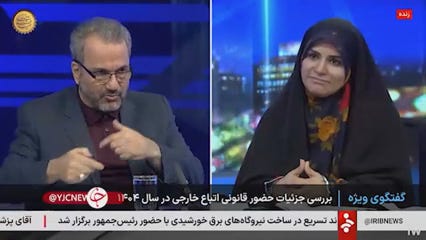On Monday evening, April 8, 2025, YJC aired a special news segment titled “Legal Presence of Foreign Migrants in 2025”, featuring Nader YarAhmadi, Advisor to the Minister of Interior and Head of the Bureau for Aliens and Foreign Immigrants Affairs (BAFIA).
According to Mohajir Times, citing YJC, YarAhmadi explained that a foreign national is someone who enters Iran with a specific purpose and through legal channels. However, many others arrive due to hardships, crossing borders illegally.
Undocumented Migrants Must Report Themselves Without Delay
“Anyone who enters Iran illegally must report to the legal authorities at the earliest opportunity,” YarAhmadi stated. “Our Bureau is actively formulating policy on this issue. Despite claims that Iran is isolated from the world, many tourists continue to visit the country.”
He noted that the government is awaiting the formation of the National Immigration Organization to implement necessary reforms and address the concerns of both Iranian citizens and migrant populations. “For over four decades, we've primarily engaged with Iraqi and Afghanistani nationals, but today, individuals from more than 100 countries—experts and laborers alike—are present in Iran.”
“There are approximately six million foreign nationals residing in Iran, some legally, others not. About 2.03 million have been registered and fall into a semi-legal category. To provide adequate services to documented migrants, those without legal status must leave the country,” he emphasized. Many undocumented individuals accept lower wages, and employers hire them without requiring residence permits. “If people are concerned about illegal migration, they must also question why these individuals are being employed,” he said.
Migrant Access to Subsidies Requires Oversight
YarAhmadi further stressed: “Without public cooperation, the cost of resolving the migration issue will be immense. All residents—including foreign nationals—benefit from subsidized bread and essential goods. This must be monitored by the Organization for Targeted Subsidies.” He clarified that individuals with census slips hold no real advantage over undocumented migrants—except that they self-reported. “We must now decide on the legitimacy of their presence.”
Afghan Migrants Concentrated in Industrial Hubs
“In major provinces such as Tehran, Khorasan, Yazd, Isfahan, and Shiraz, we see high concentrations of Afghan nationals, many of whom are employed in industrial sectors. Iranians, despite enduring four decades of sanctions, have consistently shown generosity and hospitality.”
“We have informed the Afghan government of our willingness to invest in their country. We currently operate several technical training centers there, though they are inactive. With cooperation, we could revive them and train workers for employment,” YarAhmadi said. Migration, he added, has become a permanent issue—not only in Iran, but globally. “We're not dealing with a country eager to repatriate its citizens. Organizing migrants does not depend solely on us—it requires Afghanistan’s collaboration.”
YarAhmadi announced that the foreign national census will be completed by July, and decisions about their status will be made within the first half of the year. “Border forces cannot treat those entering from the east as aggressors—we face legal constraints.” He noted that all government agencies now recognize the need for a coordinated migration strategy. “We are facing a long-term challenge. But with the right approach, what seems a threat today could become an opportunity.”
Legal Pathways and Protection for At-Risk Migrants
“Many foreigners enter Iran with passports and are eligible for one-year or longer residence permits. With an investment of $100,000, one can obtain residency. Those who claim to be at risk and unable to return to their countries receive residence cards defining their status.” But YarAhmadi stressed: “Undocumented migrants must return to their countries of origin, obtain passports, and then re-enter Iran legally. We cannot create opportunities or offer services to those who remain outside the law.”
12% of Afghans in Iran Are School-Age Children
“Roughly 12% of Afghans in Iran are enrolled in schools, compared to 16% of Iran’s own population,” he added. He acknowledged that several document-forging networks have been uncovered and dismantled by police, but emphasized: “The scale of these operations is not large enough to disrupt the broader effort to regularize the migrant population.”
“Our services for those with legal residency are being delivered with high quality. Sadly, public discourse—especially online—often includes racist rhetoric,” YarAhmadi concluded. “Importantly, the draft bill for the National Migration Organization adopts no security-based approach. It is focused on management, not surveillance.” #mohajirtimes













Share this post